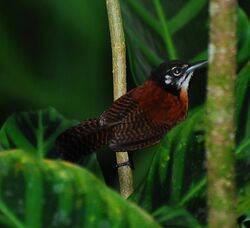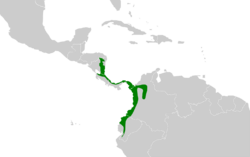Biology:Bay wren
| Bay wren | |
|---|---|

| |
| In Costa Rica | |
| Scientific classification | |
| Domain: | Eukaryota |
| Kingdom: | Animalia |
| Phylum: | Chordata |
| Class: | Aves |
| Order: | Passeriformes |
| Family: | Troglodytidae |
| Genus: | Cantorchilus |
| Species: | C. nigricapillus
|
| Binomial name | |
| Cantorchilus nigricapillus (PL Sclater, 1860)
| |

| |
| Synonyms | |
|
Thryothorus nigricapillus | |
The bay wren (Cantorchilus nigricapillus) is a species of bird in the family Troglodytidae. It is native to southern Central America and northwestern South America.[1]
Taxonomy and systematics
The bay wren has sometimes been treated as conspecific with the riverside wren (Cantorchilus semibadius) but their plumages are quite different as are DNA analyses. Some authors consider the two of them a superspecies but others deny that close relationship.[2][3]
The bay wren has seven subspecies:[1]
- C. n. costaricensis Sharpe (1882)
- C. n. castaneus Lawrence (1861)
- C. n. odicus Wetmore (1959)
- C. n. reditus Griscom (1932)
- C. n. schottii Baird (1864)
- C. n. connectens Chapman (1912)
- C. n. nigricapillus Sclater (1860)
The Clements taxonomy combines the first five as the "Central American" group and the last two as the "South American" group.[4] Other authors include schottii in the South American group.[5][6]
Description
The bay wren is 12.6 to 15.6 cm (5.0 to 6.1 in) long. Eight specimens from Panama weighed 17.7 to 26.3 g (0.62 to 0.93 oz). Adults of the nominate subspecies have a black face with a narrow white supercilium, a partial eyering, and a white patch at the back of the cheek. Their crown and nape are black and the rest of the upperparts are rich chestnut. The tail is a rich brown with bold black bars. The throat and breast are white, transitioning to rufous brown on the lower belly and flanks. Black bars cross the underparts from the breast to the vent area. Juveniles have essentially the same pattern but are paler and with less well defined markings. The other subspecies vary from the nominate in the extent and intensity of some colors and the thickness and amount of barring.[3]
Distribution and habitat
The bay wren's range spans from Nicauagua to Ecuador. The subspecies are found thus:[1][3]
- C. n. costaricensis, from norththeastern Nicaragua through Caribbean Costa Rica into western Panama
- C. n. castaneus, from west-central Panama's Veraguas Province to the Canal Zone
- C. n. odicus, Isla Escudo de Veraguas off the Caribbean coast of western Panama
- C. n. reditus, the Caribbean slope of eastern Panama
- C. n. schottii, from eastern Panama's Darién Province into Antioquia and Chocó Departments of northwestern Colombia
- C. n. connectens from Cauca and Nariño Departments in southwestern Colombia into Esmeraldas Province in far northern Ecuador
- C. n. nigricapillus western Ecuador from Esmeraldas south to El Oro Province
The bay wren is closely tied to water over most of its range, though in Nicaragua the habitat is drier. It inhabits dense, fairly low, vegetation such as thickets along watercourses, overgrown clearings, roadsides, and the understory of secondary forest. It will occur in forest interiors if the undergrowth is sufficient.[3]
Behavior
Feeding
The bay wren's diet appears to be entirely invertebrates. They forage by gleaning from foliage and branches and by probing hanging vegetation and tangles of vines.[3]
Breeding
The bay wren's breeding season is between March and October in Costa Rica, between March and November in Panama, and spans January to August in Colombia. Most of the nests that have been described were "elbow-shaped" with an entrance tube, though some were more round. They were made by both sexes from plant stems, grass, and other vegetable materials and lined with finer fibers. The clutch size is usually two or three.[3]
Vocalization
The bay wren's song is loud, "a rapid repetition of clear, rich-toned, slurred, ringing whistles, trills, and warbles" sometimes given antiphonally. The species has a number of calls.[3]
Status
The IUCN has assessed the bay wren as being of Least Concern.[7] It seems to tolerate and possibly benefit from some forms of habitat modification caused by human activities, barring the complete destruction or conversion of suitable habitat. However, further study is required, and research into aspects of the species' demography in different habitats would also be of value.[3]
References
- ↑ 1.0 1.1 1.2 Gill, F.; Donsker, D.; Rasmussen, P. (January 2021). "IOC World Bird List (v 11.1)". https://www.worldbirdnames.org/.
- ↑ Remsen, J. V., Jr., J. I. Areta, E. Bonaccorso, S. Claramunt, A. Jaramillo, D. F. Lane, J. F. Pacheco, M. B. Robbins, F. G. Stiles, and K. J. Zimmer. Version 23 May 2021. A classification of the bird species of South America. American Ornithological Society. https://www.museum.lsu.edu/~Remsen/SACCBaseline.htm retrieved May 24, 2021
- ↑ 3.0 3.1 3.2 3.3 3.4 3.5 3.6 3.7 Taylor, J. (2020). Bay Wren (Cantorchilus nigricapillus), version 1.0. In Birds of the World (T. S. Schulenberg, Editor). Cornell Lab of Ornithology, Ithaca, NY, USA. https://doi.org/10.2173/bow.baywre1.01 retrieved June 7, 2021
- ↑ Clements, J. F., T. S. Schulenberg, M. J. Iliff, S. M. Billerman, T. A. Fredericks, B. L. Sullivan, and C. L. Wood. 2019. The eBird/Clements Checklist of Birds of the World: v2019. Downloaded from https://www.birds.cornell.edu/clementschecklist/download/ Retrieved August 15, 2019
- ↑ Anon. (1998). The A.O.U. Check-list of North American Birds. 7th edition. American Ornithologists’ Union, Washington, D.C.
- ↑ González, M.A., Eberhard, J.R., Lovette, I.J., Olson, S.T. and Bermingham, E. (2003). Mitochondrial DNA phylogeography of the Bay Wren (Troglodytidae: Thryothorus nigricapillus) complex. Condor 105(2): 228–238
- ↑ Cite error: Invalid
<ref>tag; no text was provided for refs namedIUCN
Wikidata ☰ Q4767755 entry
 |



